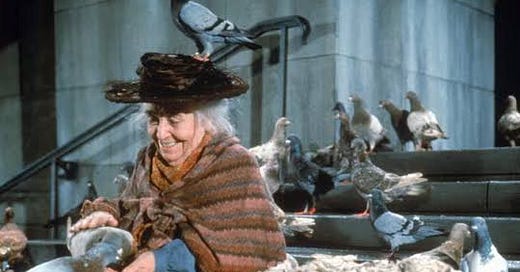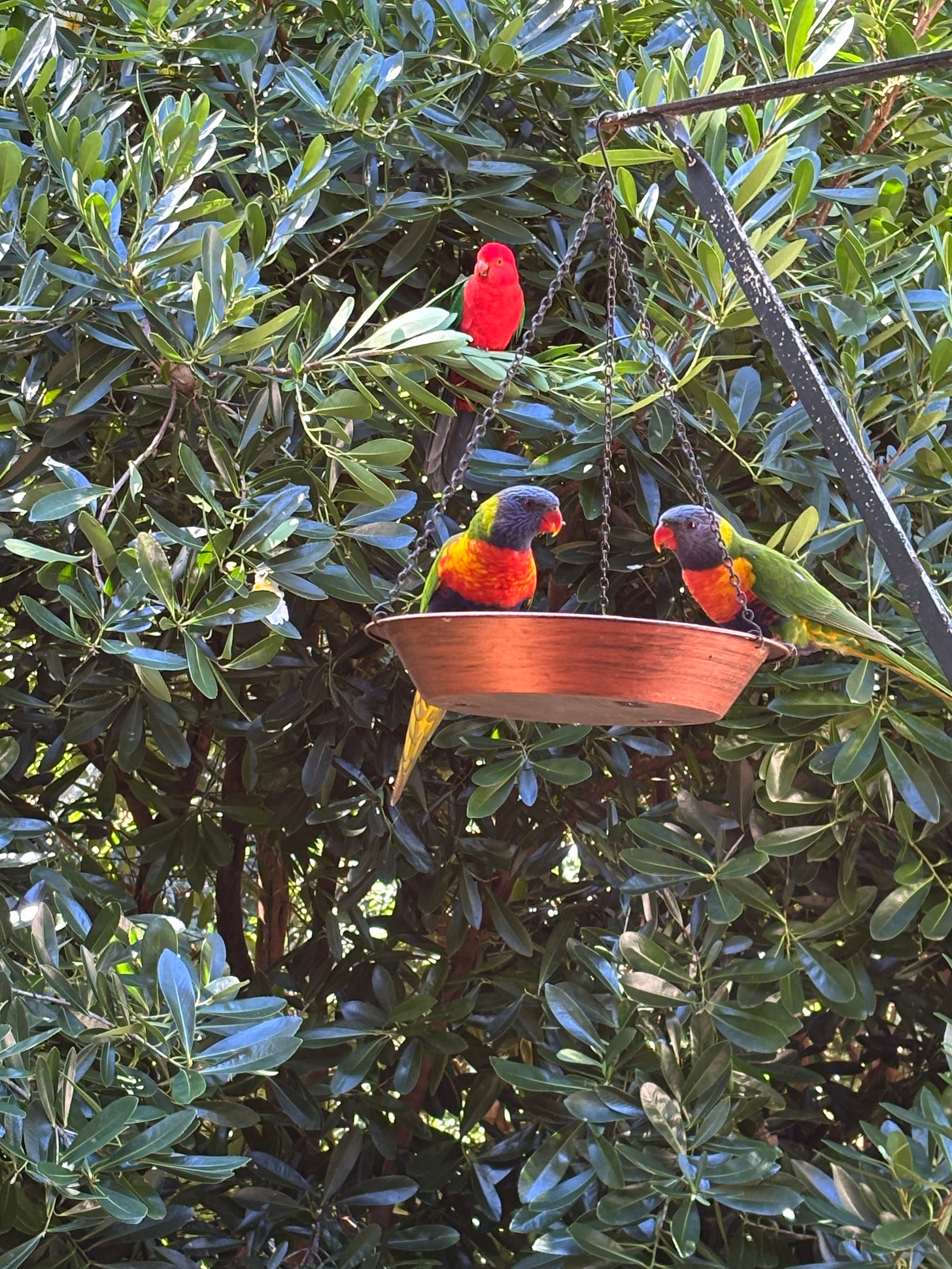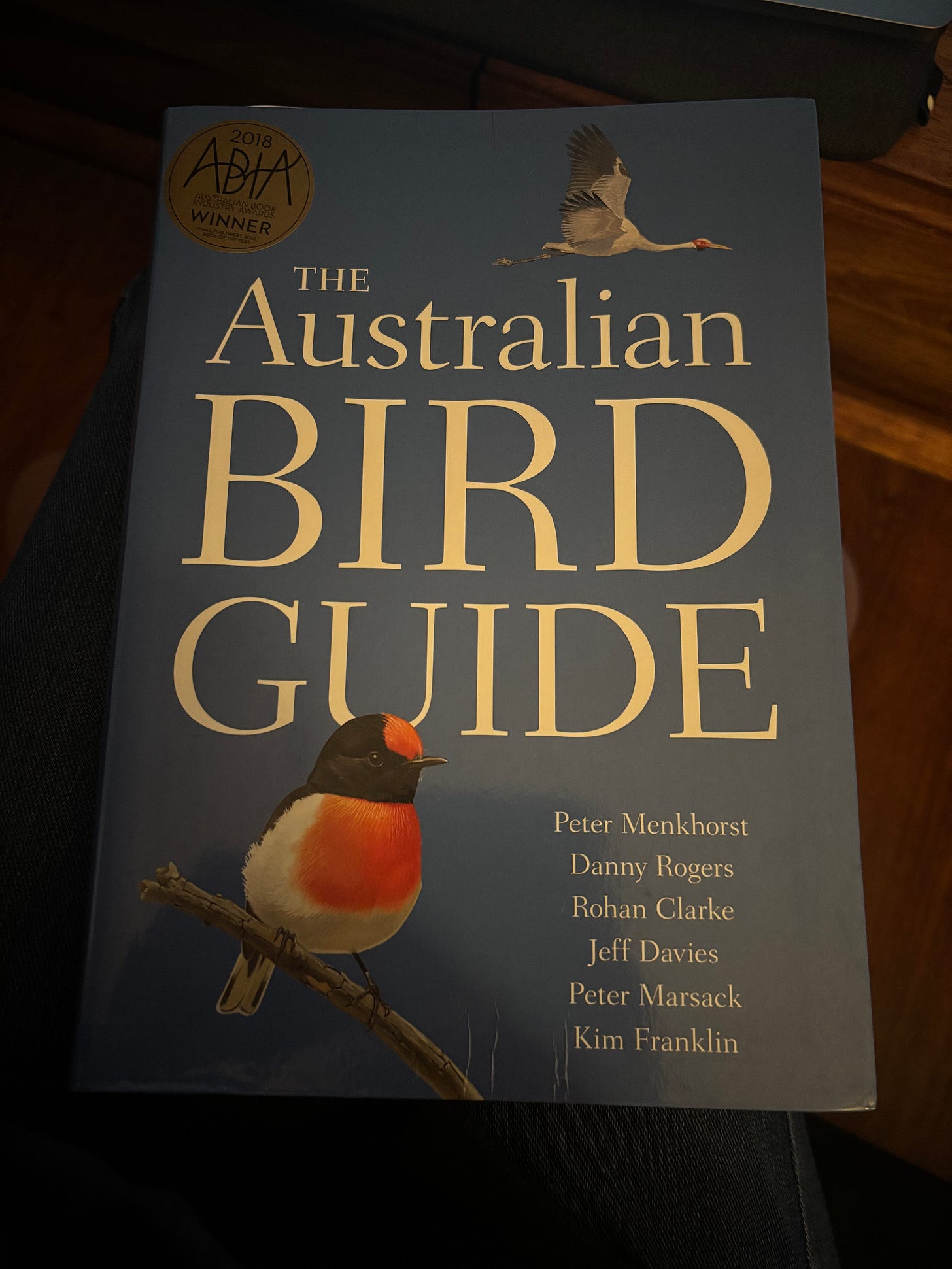It’s a truth universally acknowledged that at a certain age people (i.e. me) develop a curious fascination with birds. The feathered kind, obviously - I haven’t transformed into some leering pub geezer. And if you think you're immune, think again. I too was once indifferent. Not heartless mind you - a limping pigeon could tug at my heartstrings, and I’d often nod at a passing magpie.
But since moving to Queensland, Australia, several years ago, I have slowly morphed into a bird lady. And not the glamorous Tippi “Hitchcock” Hedren kind, no, more like the dishevelled old woman in Mary Poppins, pleading with all and sundry to feed the birds.
It stands to reason, living where we do. But as my husband and I prepare to leave our rainforest retreat and return to South-East London for an extended stint, I’ve realised just how much I’m going to miss my feathered friends - even the demonic ones. So, before I go, let me introduce you to some of the local cast. First up….
The Brush-Turkey (Alectura lathami)
Often referred to as bush or scrub turkey. With a face only a mother could love, the male brush-turkey is the single dad of the bird world. Sporting a bright golden wattle (neck bling that swells and intensifies in colour during mating season) our boy builds a giant mound with the precision of a neurotic gardener. Once the setup is ready, he courts passing females, who swing by to inspect his handiwork, lay their eggs if it meets their exacting standards, and then disappear. No “love yous,” no “thank-yous.”
From this point on, Dad takes sole responsibility for maintaining the perfect temperature - adding or removing mulch like a bird possessed, literally sticking his beak into the mound to check it's sitting at an ideal 33°C at all times.
When the chicks hatch, they dig themselves out like tiny escape artists and vanish into the bush, fully independent and immediately on the lookout for dogs, cars, and baffled humans - leaving this feathery Father 4 Justice without so much as a backwards glance.
Brush turkeys get a bad rap here in Queensland, mainly for wrecking gardens. But thankfully they’re protected under the Nature Conservation Act 1992, and it’s an offence to harm them. I’m rather fond of the daft, clumsy things. They’ve hung out with my chooks without incident and often accompany me on garden strolls, like clueless security guards.
Rainbow Lorikeet (Trichoglossus moluccanus)
These dazzling little birds travel in loud, chaotic flocks and are particularly abundant in autumn. You’ll hear their shrill, chattering calls whenever there’s food involved. Imagine a hen party boarding an EasyJet flight to Malaga, and you’ll get a sense of the racket. Brilliant to look at - less so to listen to. Earplugs recommended.
Kookaburra (Dacelo novaeguineae)
On my first trip to Australia, I was woken early one morning by what I was sure were monkeys chattering in the trees. Imagine my embarrassment when I asked the B&B owner where they lived. No monkeys, apparently - not a single one in the entire country. Which, frankly, still baffles me, given the roster of wildly eccentric animals Australia does have.
And this, mind you, is coming from someone who once wrote to Jim’ll Fix It asking for a pet chimpanzee. But the less said about that, the better.
The sound, in fact, came from a laughing kookaburra - one of Australia’s most iconic birds. In Aboriginal Dreamtime stories, their laughter is said to wake the sky people and prompt the sun to rise. They often call at dawn and dusk, earning them the nickname ‘the bushman’s clock.’
Kookaburras are monogamous and live in close-knit family groups. But don’t be fooled - they’re stocky little hard-nuts, killing prey such as lizards, snakes, and insects by whacking them against a branch or rock.
Charismatic creatures, but with a touch of the Artful Dodger about them - they’ll nick your food in the blink of an eye, as you’ll see here during a dreamy picnic with my husband. Apologies in advance and don’t be alarmed, the sound you hear is not a cross cockney urchin, but rather a peri-menopausal woman whose cake had just been swiped...
Satin Bower Bird (Ptilonorhynchus violaceus)
If Walt Disney had designed a bird, it might look something like this.
The females and juveniles are olive-green, but the adult males are glossy midnight blue-black and spend their days building elaborate display bowers - not nests, but ornamental seduction huts. These structures are decorated with anything blue they can find: bottle caps, straws, pegs, pens, flowers, berries, and stolen items like your toothbrush or laundry pegs.
Once this fella’s batchelor pad is ready, he struts, dances, and grunts around it in a bid to impress passing ‘ladies’. Alas, proving that dating is tough whatever the species, female bowerbirds sometimes shop around or swipe left, visiting multiple bowers before making a decision .
But if she’s impressed, they’ll mate. Then she’ll go off to build an actual (practical) nest and raise the chicks, “Cos I cant raise a family in your boy cave Barry! What would my mother think of the mirrored ceilings?!”
Unfortunately that’s where the effort stops. The Laurence Llewelyn-Bowen of the bird world only focuses on the wooing, not the parenting. But what a creative creature he is.
Australian King Parrot (Alisterus scapularis)
The males look like flying Christmas baubles - red head and chest, emerald wings, and a flash of royal blue on the rump. The females are green with red bellies - less flashy, understated.
These gentle birds often visit our deck. I’ll be working away on my laptop, oblivious, until I hear a polite chirrup and turn to find one perched beside me, patiently requesting attention. They can become very tame and will happily eat from your hand.
Unlike the lorikeets, they’re quiet, respectful, and egalitarian - both parents share the childcare.
Eastern Whipbird (Psophodes olivaceus)
On an early visit to Tamborine Mountain, my husband and I were woken by what sounded like a whip crack followed by frantic thumping at the window. Expecting a bird the size of an ostrich, we cautiously peeked out and found a tiny creature, barely the size of my hand. But what he lacked in height, he made up for in voice.
We won’t labour on the point that he was attempting to mate with his own reflection, instead I will say that the elusive Eastern Whipbird is best known for its iconic ‘whip-crack’ call - like someone snapping a wet towel in the rainforest. But here’s the twist: it’s a duet. The male does the whip, the female replies with a soft “chew-chew” or “tick-tick.”
Just lovely.
Sulphur Crested Cockatoo (Cacatua galerita)
Or, as I call them, clumsy bastards. Spectacular to look at with their punk-rock crests, but completely unaware of their own size. They repeatedly try to perch on dainty bird feeders they’re far too heavy for, then tip them over in frustration, scattering seed from a great height - usually while staring you down through the kitchen window.
They also scream like banshees. Nails-on-a-chalkboard kinda thing.
Pied Currawong (Strepera graculina)
Speaking of anti-social behaviour: enter the Pied Currawong. According to Aboriginal tradition, they’re considered spiritual messengers - harbingers of transition, be it weather, life stage, or spiritual shift.
Which is spooky, because one’s appeared in our garden every day for the past month.
At first, I mistook it for a magpie - those cyclist-hating buggers I’ve spoken about before, here;
But the currawong is bigger, with a yellow eye ring and the unnerving aura of a creature who knows things. They’re also omnivorous opportunists. This one took a keen interest in my chooks, hovering nearby like a crackhead bothering girls at a bus stop. I often race out, arms flailing, but these birds don’t scare easily. In fact, this one merely looked me up and down, before flying off muttering, “Alright, calm down. I was only asking for a light.”
Interestingly, Pied Currawongs stash food in tree forks and roof gutters, like feathered doomsday preppers. You’ll either love them or loathe them. I’m undecided.
As for other birds in our vicinity, a few notable mentions include the lesser-spotted sooty owl (Tyto tenebricosa), whose haunting call at night resembles the sound of a falling bomb. Then there's the tawny frogmouth (Podargus strigoides), often mistaken for owls, though they actually belong to the nightjar family. And of course, the masked lapwing (Vanellus miles), commonly known as plovers. With their striking yellow facial patch, these avian Zorros are fiercely protective of their eggs, attacking any perceived threats. However, they might want to reconsider their risky preference for nesting in car parks - it's a bit of a daft move. Last but not least, the mimic of the rainforest, who I’ve mentioned on previous occasions, the glorious Lyrebird (Menura novaehollandiae).
As my time in Australia draws to a temporary close, I know I'll miss these remarkable creatures, more than I care to admit. There's something deeply comforting about their constant presence. They’re more than just birds - they’ve been part of the soundtrack to this chapter of my life. So while I'm in London, I'll carry a little piece of Queensland with me - in the form of fond memories of my beautiful feathered friends.
Thanks for the heartfelt response to my last piece below, and for helping me get to 200 subscribers! Am proper chuffed.
Ways to Support My Writing…
❤️ If you enjoyed reading, please click on the heart below.
🔄 Restack and share, allowing others to find me.
🗣️ Leave me a comment - I always respond.
Leave me a tip 🍺 ☕️
Become a 🆓 or paid subscriber 👇












Enjoyed this, Sharon! Hope the many pigeons in London are filling the void your more colourful feathered friends have left.
Jim'll Fix It... yikes. We went on a school outing to sit in the audience and watch the show live. One of my friends was called up on stage. Lucky for her, she wasn't taken backstage.
This makes me want to visit Australia, or actually live there a while to have such cool visitors. That's pretty neat how the brush turkey male looks after the young. They look like feisty types. Those satin bower birds sure know how to throw stuff together. Haha. For me, I think the Australian king parrot seems like quite a nice visitor. Not too loud and so respectful and friendly. I bet you will miss all those cool creatures. Thank you for sharing, Sharon.